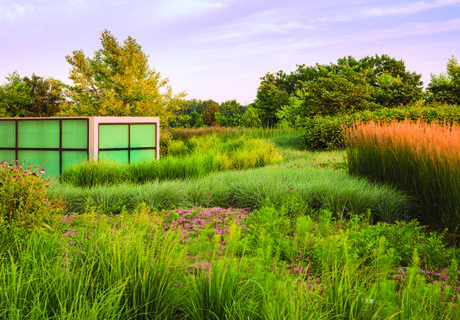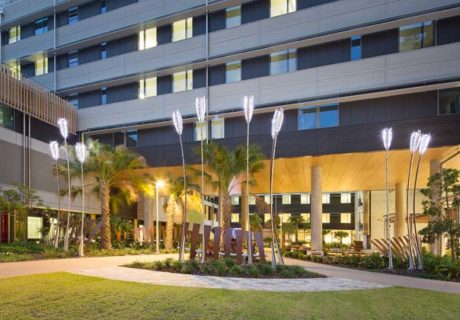Legacy Emanuel Medical Center Plants With Purpose
A new garden filled with a profusion of plants on a second-floor terrace at Legacy Emanuel Medical Center in Portland, Ore., provides a lush setting to test the impact—for patients, visitors, and hospital staff—of a therapeutic nature space on hospital grounds. The Terrace Garden, located adjacent to the hospital’s birthing center and cardiovascular intensive care unit (ICU), was constructed between September 2013 and March 2014, on an underutilized terrace overlooking the medical center’s central courtyard and the fancifully designed Children’s Garden. Covering a modest 6,900-square-foot space, the new garden offers sun and shade, with benches, chairs, and tables in varied configurations and areas to accommodate groups or provide privacy. With well-designed perimeters and an always-changing, four-seasons array of plants, sights, and smells, it’s open 24 hours and accessible to patients and visitors with a wide range of physical conditions and needs.
The benefits of access to nature have been shown in a variety of settings and contexts, notes Roger S. Ulrich, an international leader in evidence-based healthcare design and a consultant to Legacy Health’s therapeutic gardens program. The Terrace Garden project uses evidence-based design research tools, including randomized controlled clinical trials and other techniques, to document outcomes for mothers in early labor, family members of patients in the ICU, and hospital staff who spend time in the outdoor space. In some cases these groups are compared to matched control groups that don’t have access to the gardens. When that’s not possible, researchers simply observe interactions in the garden
“The overall goal [of this project] is to assess through rigorous study what, if any, benefits accrue to individuals from such a garden,” Ulrich says, to generate important knowledge about the value of gardens and of access to nature in hospital settings.
The three-hour design team
The Terrace Garden at Legacy Emanuel was designed with the same standardized interdisciplinary design process that the six-hospital health system has used for 10 other hospital gardens, most of which are for specific patient populations, such as hospitalized children or stroke or burn patients. A 20-member team of key stakeholders, including a landscape architect, physicians, clinical and administrative leaders from the hospital, community partners, and past hospital patients, met three times in 2012 to develop their vision for the garden.
The Legacy system has emphasized therapeutic gardens since 1991, when Teresia Hazen, a registered horticultural therapist, became its full-time gardens coordinator. Best practice guidelines for these gardens, she says, are drawn from the American Horticultural Therapy Associatoin’s seven therapeutic garden characteristics.
All of Legacy’s gardens have been planned by clinicians who care for the patients using the gardens, Hazen adds. The multidisciplinary, bottom-up planning process is built on a clear statement of purpose, brainstorming ideas within a designated time frame and exploring alternative designs—all in three one-hour meetings. Hazen insists on shepherding the process through this time frame as a courtesy to busy clinical staff.
“Physicians, therapists and other clinicians have first-hand knowledge of their clients’ diagnoses and assessment data, including physical, emotional, and spiritual needs,” Hazen explains. “During the garden planning process, an occupational therapist may advocate for garden settings with hands-on sensory opportunities, while the physician may suggest a nature setting close to the medical unit to encourage patients and families to walk daily in the garden.
“I don’t say ‘healing gardens’—I call them ‘therapeutic gardens,’ because clinicians helped to design them and they’re intended to offer therapeutic benefit to all,” she adds. “Our mantra is ‘rehabilitation, recovery, and restoration.’ If they don’t serve as powerful clinical tools for patients, family, and staff, then our money was not well spent.”
A commitment to clinical research
But what distinguishes the Legacy Emanuel project from the system’s other gardens is the commitment to clinical research, supported with a $560,000 grant from the TKF Foundation (Annapolis, Md.), a philanthropy dedicated to the creation of spaces that provide opportunities to connect with nature.
In 2013, TKF issued six national Nature Sacred Awards totaling $4.5 million to research-oriented, cross-disciplinary projects studying outcomes such as stress reduction, emotional healing and personal resiliency, and how nature can touch people in crisis.
Legacy’s research team had to work through a number of methodological issues right from the start; for example, there was concern that enthusiasm expressed early on about the project might create a placebo effect for garden users. The researchers developed scripts for introducing their studies to potential subjects using impartial wording. Enrolling enough subjects to power the studies was another challenge, so a second ICU, one floor up from the Terrace Garden, was added to increase the participant pool.
Hospital staff that consent to participate in the study of how designated time spent in the garden affects their stress management will be randomized to garden and control groups in alternating six-week periods.
The randomized family birthing study will assess effects on full-term, low-risk expectant mothers who access the garden for walking, sitting, and resting during early stages of labor, before returning to birthing rooms for delivery. The researchers will measure the extent to which access to the garden may lessen their discomfort, pain, and stress—as well as the impact on their babies’ conditions at birth—compared with controls. With prior research showing that the mom’s stress level can influence delivery, “We’re trying to find out if gardens are actually helpful and show measurable benefits in early stages of labor,” Ulrich says.
The ICU family study could not be randomized because of ethical concerns about denying garden access to highly stressed family members of ICU patients. Instead, the researchers designed an observational study to try to identify benefits experienced by any ICU families who visit the garden. A fourth, post-occupancy study is also planned, with several months spent observing people who use the garden and their patterns of use—what they do in the garden, where they sit, and which plants and design features they respond to.
Are hospital gardens clinically effective?
It’s just common sense that most people will say a garden makes them feel more peaceful, says Dr. Alar Mirka, director of clinical research at the Legacy Research Institute and a member of the Terrace Garden research team. “But trying to turn that into scientific questions, with hypotheses that can be tested, is harder to do. One of the tools we’ve developed is a questionnaire to translate the complexities of emotional experience into data,” which utilizes, for example, the visual analog scale to quantify subjective measures such as emotional state.
Ulrich, a professor at the Center for Healthcare Architecture at Chalmers University (Gothenburg, Sweden), says there’s a growing body of research on therapeutic gardens, with evidence that well-designed access to nature f
or patients and other hospital users can help reduce healthcare costs and increase customer satisfaction. He was in Portland in June for research meetings and press events related to the Terrace Garden research project.
“It’s amazing how far things have come and how quickly,” he said at a press conference. “But there’s still a long way to go. We need much more research to see if the benefits really are there—are gardens truly effective clinically? Many knowledge gaps remain, and there have been few controlled trials measuring outcomes in hospital gardens.”
The field needs to carry out scientifically sound outcomes research with sufficient rigor to qualify for publication in medical journals, which carry weight with decision makers, medical administrators, and clinicians, he adds. This kind of research is costly and requires a multidisciplinary team collaborating on study design, development, and evaluation.
“There’s always a risk that when rigorous randomized controlled trials are carried out, the findings will not be positive. Science allows methods to disprove researchers’ expectations. We hope that the new garden will show beneficial results, but there will be some surprises. Whatever we find will advance the overall knowledge base,” Ulrich says.
The Legacy garden researchers plan to announce their findings at a public event on-site in October 2015.
Larry Beresford is an Alameda, Calif.-based journalist. He can be reached at larryberesford@hotmail.com.




